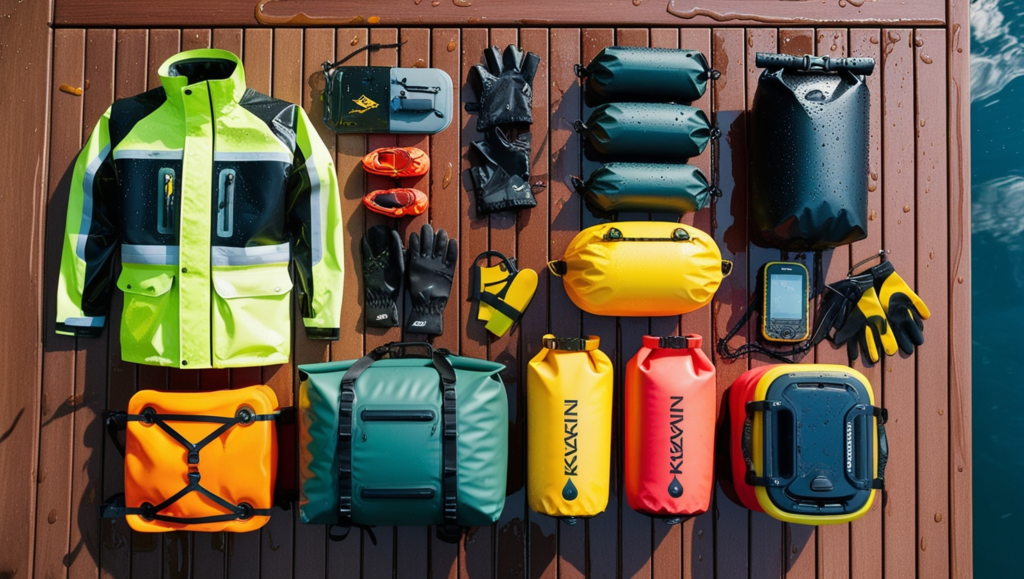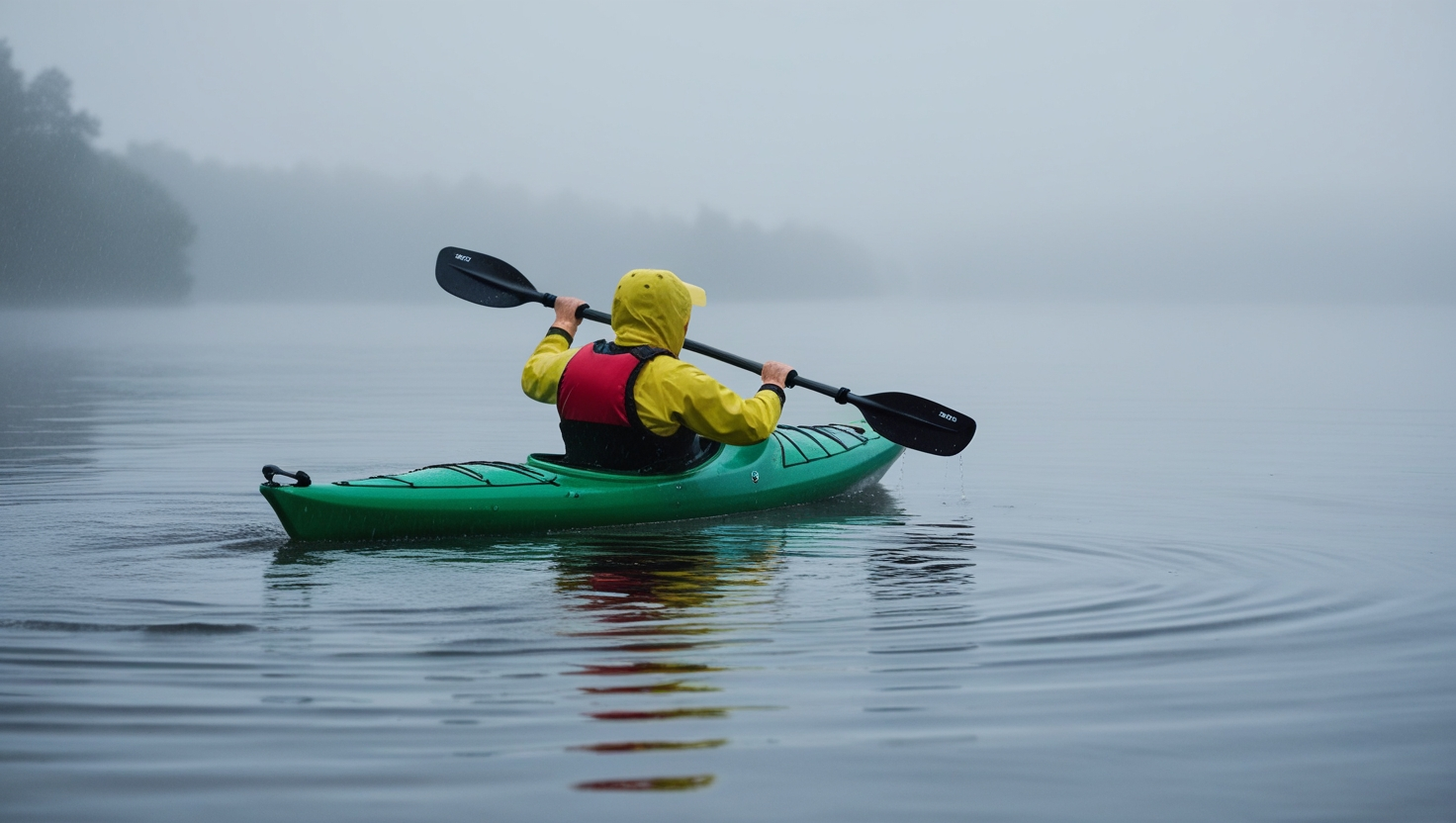Have you ever noticed how raindrops transform an ordinary paddling session into something extraordinary? Imagine gliding through mirror-like waters while countless droplets create a mesmerizing symphony around you. Welcome to the enchanting world of kayaking in the rain – an experience that turns what many consider deterrent weather into your personal aquatic wonderland.
Why You Should Consider Kayaking in the Rain
Think about your most memorable kayaking adventures. Now, picture those same experiences enhanced by the gentle patter of rain, creating a cocoon of tranquility around you. Rainy conditions offer unique advantages that fair-weather paddling simply can’t match.
When you venture out during a light shower, you’ll discover waterways transformed into peaceful sanctuaries. Gone are the crowds that typically populate popular paddling spots, replaced by an almost meditative solitude. Wildlife behaves differently too – birds swoop lower, fish become more active, and the entire ecosystem seems to pulsate with renewed energy.
The cooler temperatures that accompany rain make for more comfortable paddling conditions, especially during warmer months. You’ll find yourself naturally connecting with nature’s rhythm, experiencing the environment in its most authentic state.
Safety First: Essential Preparations
Weather Monitoring
Before you grab your paddle and embrace the rain, understanding weather patterns becomes your first line of defense. Distinguished paddlers know the crucial difference between a gentle shower and potentially hazardous conditions. Download reliable weather apps that provide detailed forecasts, including wind speeds and precipitation levels.
Keep your eyes on these key weather indicators:
- Cloud formations and movement patterns
- Wind direction and speed variations
- Radar images showing precipitation intensity
- Lightning probability forecasts
Required Safety Gear
Your safety equipment needs a rainy-day upgrade. Here’s a comprehensive breakdown of essential items:
| Essential Item | Purpose | Recommended Features |
|---|---|---|
| Rain Jacket | Weather Protection | Breathable, waterproof material with sealed seams |
| Dry Bags | Equipment Protection | Multiple sizes, roll-top closure system |
| Emergency Kit | Safety | Waterproof container with first aid supplies |
| Visibility Aids | Safety | LED lights, reflective strips, bright colors |
Proper Gear for Rainy Day Kayaking

Clothing Selection
Your comfort and safety largely depend on wearing appropriate layers. Start with moisture-wicking base layers that keep your skin dry. Add an insulating middle layer during cooler conditions, and top it off with a high-quality waterproof outer layer.
Consider these essential clothing items:
- Quick-drying synthetic underlayers
- Neoprene gloves with textured palms
- Water-resistant paddling pants
- Waterproof socks or paddling boots
Equipment Protection
Water-sensitive gear requires special attention during rainy adventures. Invest in quality dry bags of various sizes to protect:
- Electronics and communication devices
- Emergency supplies
- Extra clothing
Advanced Techniques for Rain Kayaking

Paddling Adjustments
Rain creates unique paddling conditions that require technique modifications. You’ll want to:
- Adjust your stroke angle to account for wind
- Maintain a slightly more forward posture
- Keep your paddle strokes shorter and more frequent
- Pay extra attention to your surrounding environment
Navigation Tips
Reduced visibility demands enhanced navigation skills. Familiarize yourself with these strategies:
- Use prominent landmarks as reference points
- Keep your GPS in a waterproof, accessible location
- Study your route thoroughly before departure
- Mark key waypoints for easy reference
After-Adventure Care
Equipment Maintenance
Proper post-rain care extends your gear’s lifespan significantly. Follow these maintenance steps:
- Thoroughly dry all equipment before storage
- Inspect seams and closures for water damage
- Clean and treat waterproof materials as needed
- Check electronic equipment for moisture exposure
Personal Care
Taking care of yourself after a rainy paddle is equally important:
- Change into dry clothes immediately
- Perform light stretches to warm up
- Consume warm beverages and energy-rich snacks
- Monitor your body temperature
Frequently Asked Questions About Kayaking in the Rain
Q: Is it safe to kayak in the rain?
A: Kayaking in the rain is safe when you follow proper precautions. Key safety measures include checking weather forecasts, wearing appropriate rain gear, using visibility aids, and avoiding conditions like thunderstorms or heavy winds. Always inform someone of your paddling plans and carry emergency communication devices in waterproof containers.
Q: What essential gear do I need specifically for kayaking in the rain?
A: For safe and comfortable kayaking in the rain, you’ll need:
- Waterproof, breathable rain jacket and pants
- Multiple dry bags for electronics and spare clothes
- High-visibility gear or reflective strips
- Proper layering clothing (moisture-wicking base layer)
- Waterproof GPS or compass
- Emergency kit in waterproof container
- Neoprene gloves and waterproof footwear
Q: How does rain affect kayaking conditions on different water bodies?
A: Rain impacts kayaking conditions differently depending on the water body:
- Lakes: Reduced visibility and changed surface conditions
- Rivers: Possible water level changes and stronger currents
- Coastal Waters: Affected wave patterns and reduced visibility
- Always check local conditions before heading out.
Q: What’s the best time to go kayaking in the rain?
A: The optimal time for kayaking in the rain is during light to moderate rainfall in warmer months. Early morning or late afternoon showers often provide the most stable conditions. Avoid paddling during:
- Thunderstorms or lightning
- Heavy downpours
- Strong winds
- Cold weather rain
Q: Can I use my regular kayak for rainy conditions?
A: Yes, you can use your regular kayak in the rain, but ensure it has:
- Proper drainage systems
- Sealed compartments
- Functional scupper holes (if sit-on-top)
- Well-maintained hatch covers
Regular maintenance becomes even more crucial when frequently kayaking in wet conditions.
Q: How should I maintain my kayaking gear after paddling in the rain?
A: After kayaking in the rain:
- Dry all equipment thoroughly
- Clean and inspect seals and gaskets
- Check electronic equipment for water damage
- Air out and dry storage compartments
- Treat waterproof clothing to maintain its effectiveness
Q: Are there special paddling techniques for rainy conditions?
A: Yes, rainy conditions require adjusted paddling techniques:
- Shorter, more frequent strokes
- Enhanced awareness of surroundings
- Modified forward posture
- Adjusted paddle angle for wind conditions
Practice these techniques in mild conditions before attempting more challenging rainy weather.
Embrace the Rain: Your Next Adventure Awaits
Kayaking in the rain opens up a whole new dimension of paddling experiences. When properly prepared, these wet adventures often become the stories you’ll share most enthusiastically. The key lies in respecting the conditions while embracing the unique opportunities they present.
Remember, every raindrop adds another layer to your paddling story. The solitude, the enhanced connection with nature, and the sense of accomplishment make rainy day kayaking an adventure worth pursuing.
Ready to transform your next rainy day into an unforgettable paddling experience? Share your own rainy kayaking stories in the comments below, or tell us about your favorite wet-weather paddling spots. Don’t forget to check our gear recommendations section for everything you need to get started.
Happy paddling, rain or shine!

